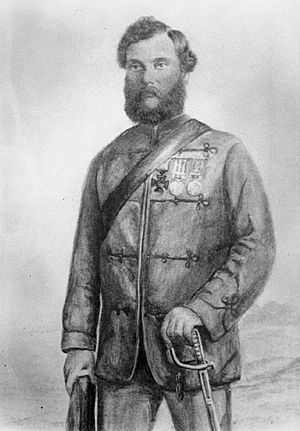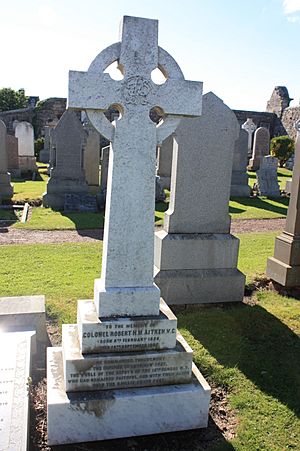Robert Hope Moncrieff Aitken facts for kids
Quick facts for kids
Robert Hope Moncrieff Aitken
|
|
|---|---|
 |
|
| Born | 6 February 1826 Cupar, Fife |
| Died | 18 September 1887 (aged 61) St Andrews, Fife |
| Buried |
Eastern Cemetery, St Andrews
|
| Allegiance | |
| Service/ |
|
| Rank | Colonel |
| Battles/wars | Second Anglo-Sikh War Indian Mutiny |
| Awards | Victoria Cross Order of the Bath |
Robert Hope Moncrieff Aitken was a brave Scottish soldier. He was born on February 8, 1826, and passed away on September 18, 1887. He earned the Victoria Cross, which is the highest award for bravery in the United Kingdom and Commonwealth of Nations. This medal is given to soldiers who show amazing courage when facing the enemy.
Contents
What Was Robert Aitken's Act of Bravery?
Robert Aitken was a lieutenant in the Bengal Army when he showed incredible bravery. This happened during the Indian Mutiny in 1857. He was 31 years old at the time. His actions helped defend the Residency of Lucknow for many months.
How Did He Show Courage in the Garden?
Lieutenant Aitken went into a dangerous garden three times. This garden was very close to where the enemy was hiding. Twice, he rescued cattle that were left there.
On July 3, the enemy set fire to a large pile of hay in the garden. Everyone worried the fire would reach the gunpowder storage nearby. Aitken, with other officers, bravely went into the garden. They cut down tents that could have spread the fire to the gunpowder. They did this right next to the enemy's hiding spots. The flames made it bright, making them easy targets. It was a very risky mission.
How Did He Save the Baillie Guard Gate?
On the night of August 20, the enemy set fire to the Baillie Guard Gate. Lieutenant Aitken was the first person to reach the burning gate. With the help of some soldiers and a water-carrier, he partly opened the gate. He did this while the enemy was shooting heavily. He then removed the burning wood and straw. His quick actions saved the gate from being destroyed.
How Did He Capture Enemy Guns?
On September 25, Aitken led a small group of twelve soldiers. Their mission was to attack two enemy guns. These guns were aimed at a friendly army column. Aitken and his men successfully captured the guns. After that, he attacked and took over a building called the Teree Kotee with his small force.
How Did He Take the Furreed Buksh Palace?
The next morning, on September 26, Aitken led another small group. They attacked the barricaded gateway of the Furreed Buksh Palace. He bravely jumped towards a small side gate. He held it open, stopping the enemy from closing it. This allowed his soldiers to rush inside. His amazing bravery was key to taking the palace.
What Was His Role in the Later Attack?
On September 29, Aitken volunteered for another dangerous task. He went with four soldiers to capture an enemy gun that was still firing. They moved through houses and narrow lanes to reach the gun. The enemy shot at them from the buildings. But Aitken and his men held their ground. When more soldiers arrived, they managed to flip the gun over. They then brought it safely back to the Residency. They also captured another gun later.
What Happened After His Brave Actions?
Robert Aitken continued his military career. He eventually reached the high rank of Colonel. He passed away in 1887 and is buried in the Eastern Cemetery in St Andrews, Scotland.
Who Was Robert Aitken's Family?
Robert was the son of John Aitken and Jane Christie. His family had a long history of serving in the army. His cousin, Robert Digby-Jones, also received the Victoria Cross. This was for his actions in 1900.
What is Robert Aitken's Legacy?
Robert Aitken's Victoria Cross medal is now kept at the National Army Museum in Chelsea, England. What makes his story special is where he received his award. The ceremony happened at the Residency at Lucknow. This was almost the exact place where he performed many of his brave acts. However, he did not get the actual medal that day because it had been misplaced.
A special memorial was built at the Residency in Lucknow to honor him. It says:
This monument is erected to the memory of Colonel Robert Hope Moncrieff Aitken VC Bengal Staff Corps and formerly of the 13th Regt Bengal Infantry, by some of his surviving comrades and other friends in token of their appreciation of his sterling worth as a man, and of the splendid gallantry and chivalrous devotion which he displayed as a soldier in command of this post, which he held with the faithful and loyal remnant of the Regiment to which he belonged throughout the defence of the Residency of Lucknow.



